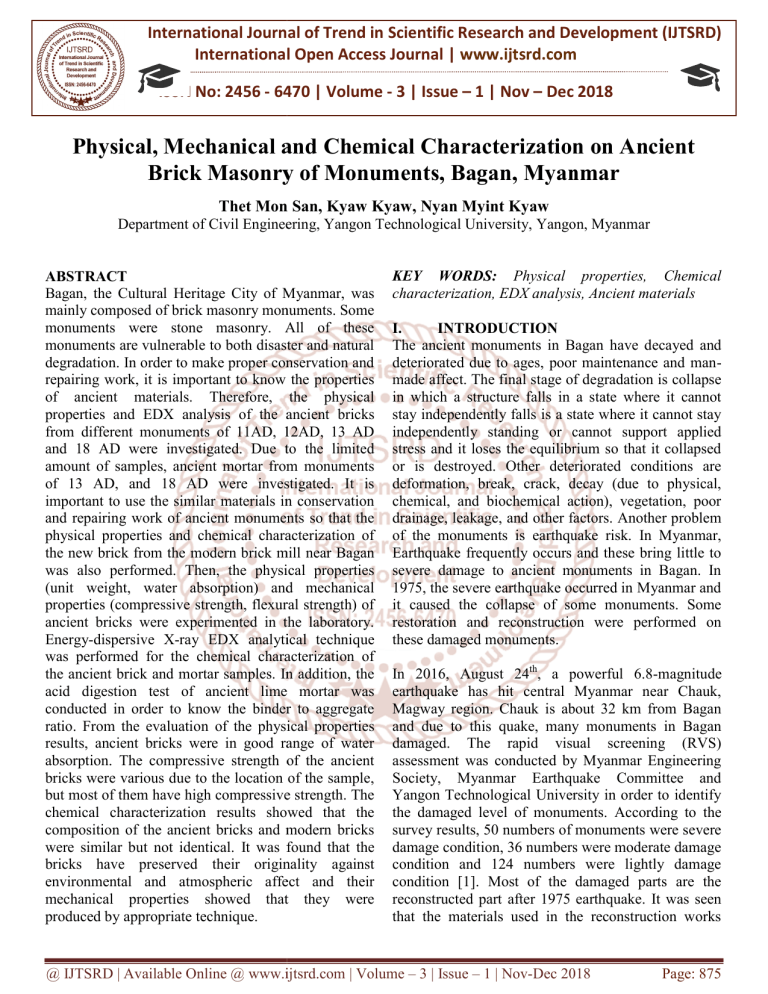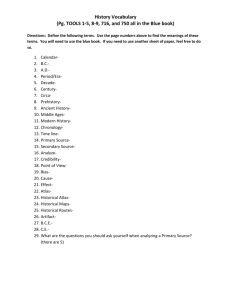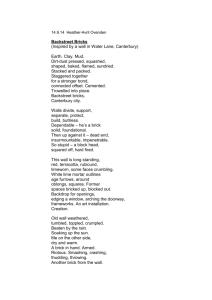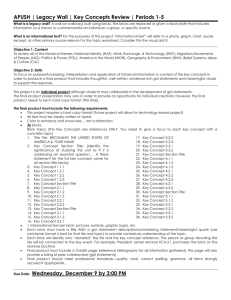
International Journal of Trend in Scientific Research and Development (IJTSRD)
International Open Access Journal | www.ijtsrd.com
ISSN No: 2456 - 6470 | Volume - 3 | Issue – 1 | Nov – Dec 2018
Physical, Mechanical and Chemical Characterization on Ancient
Brick Masonry ooff Monuments, Bagan, Myanmar
Thet Mon San, Kyaw Kyaw, Nyan Myint Kyaw
Department off Civil Engineering, Yangon Technological University, Yangon,
Yangon Myanmar
ABSTRACT
Bagan,, the Cultural Heritage City of Myanmar, was
mainly composed of brick masonry monuments. Some
monuments were stone masonry. All of these
monuments are vulnerable to both disaster and natural
degradation. In order to make proper conservation and
repairing work,
ork, it is important to know the properties
of ancient materials. Therefore, the physical
properties and EDX analysis of the ancient bricks
from different monuments of 11AD, 12AD, 13 AD
and 18 AD were investigated. Due to the limited
amount of samples, ancient
ient mortar from monuments
of 13 AD, and 18 AD were investigated. It is
important to use the similar materials in conservation
and repairing work of ancient monuments so that the
physical properties and chemical characterization of
the new brick from the modern
odern brick mill near Bagan
was also performed. Then, the physical properties
(unit weight, water absorption) and mechanical
properties (compressive strength, flexural strength) of
ancient bricks were experimented in the laboratory.
Energy-dispersive X-ray EDX analytical technique
was performed for the chemical characterization of
the ancient brick and mortar samples. In addition, the
acid digestion test of ancient lime mortar was
conducted in order to know the binder to aggregate
ratio. From the evaluation of the physical properties
results, ancient bricks were in good range of water
absorption. The compressive strength of the ancient
bricks were various due to the location of the sample,
but most of them have high compressive strength. The
chemical characterization
erization results showed that the
composition of the ancient bricks and modern bricks
were similar but not identical. It was found that the
bricks have preserved their originality against
environmental and atmospheric affect and their
mechanical properties showed that they were
produced by appropriate technique.
KEY WORDS: Physical properties, Chemical
characterization, EDX analysis, Ancient materials
I.
INTRODUCTION
The ancient monuments in Bagan have decayed and
deteriorated due to ages, poor maintenance and manman
made affect. The final stage of degradation is collapse
in which a structure falls in a state where it cannot
stay independently falls is a state where it cannot stay
independently standing
ng or cannot support applied
stress and it loses the equilibrium so that it collapsed
or is destroyed. Other deteriorated conditions are
deformation, break, crack, decay (due to physical,
chemical, and biochemical action), vegetation, poor
drainage, leakage,
e, and other factors. Another problem
of the monuments is earthquake risk. In Myanmar,
Earthquake frequently occurs and these bring little to
severe damage to ancient monuments in Bagan. In
1975, the severe earthquake occurred in Myanmar and
it caused the collapse of some monuments. Some
restoration and reconstruction were performed on
these damaged monuments.
In 2016, August 24th, a powerful 6.8-magnitude
6.8
earthquake has hit central Myanmar near Chauk,
Magway region. Chauk is about 32 km from Bagan
and due to this quake, many monuments in Bagan
damaged. The rapid visual screening (RVS)
assessment was conducted by Myanmar Engineering
Society, Myanmar Earthquake Committee and
Yangon Technological University in order to identify
the damaged level of monuments. According to the
survey results, 50 numbers of monuments were severe
damage condition, 36 numbers were moderate damage
condition and 124 numbers were lightly damage
condition [1]. Most of the damaged parts are the
reconstructed part after 1975 earthquake. It was seen
that the materials used in the reconstruction works
@ IJTSRD | Available Online @ www.ijtsrd.com | Volume – 3 | Issue – 1 | Nov-Dec
Dec 2018
Page: 875
International Journal of Trend in Scientific Research and Development (IJTSRD) ISSN: 2456-6470
2456
were different from ancient ones. The reconstructed
brick sizes were smaller than the ancient bricks.
Therefore, for the rehabilitation of the damaged
monuments of 2016 post earthquake recon
reconstruction
and repair work, the thorough understanding of the
materials used in the structure is definitely required. A
full understanding of the structural and material
characteristics is required in conservation practice [2].
Most of the monuments in Bagann are brick masonry
with mud mortar and lime mortar. All the structures
except the upper parts and the decorations are heavy
and massive [3]. The purpose of this study is to get
appropriate technical scientific information of the
ancient brick and mortar inn order to use the
compliable materials in rehabilitation of monuments.
Therefore, the investigation of old bricks in chemical
and physical character was conducted in this study.
Moreover, the same investigation was performed on
the modern bricks for the conservation
onservation and
rehabilitation work.
II.
HISTORICAL BACKGROUN
BACKGROUND
In 638 A.D, the Pyu, which are Tibeto
Tibeto-Burman,
founded the first big Buddhist capital of Burma, Sri
Ksetra [4]. The last Sri Ksetra king died in 718 A.D
[4]. Sometime later, it seems, the city fell
fell; and the Pyu
fell back on Upper Burma, making their new capital
Hanlin, 10 miles south of Shwebo [4]. In 850, it is
said, the Burmans, Mranma built the wall of Bagan
then the advance center, rather than the capital of
Tambadipa, the first kingdom of the B
Burmans in the
Central Burma [4]. Compared to the fertile Kharuin
areas, Kyaukse and Minbu, Bagan is “the parched
country”, Tattadesa, of Old Mon inscriptions
[4].Apart from the strange eroded ravines above
Naung-U,
U, Bagan is just a sandy windswept plain,
strewn
rewn with bright pebbles and fossil wood, and
sparsely shadowed by low, straining, thorny trees:
euphorbia, osyris, jujube, cutch and beautiful white
whitebarked acacia[4].A few big trees, tamarind and Indian
elm and bombax, tower magnificent where there is
subsoil water; also the toddy-palm,
palm, Palmyra; and
some of the humbler plants flower prettily enough, but
are too dry for fodder[4]. Bagan, erstwhile capital of
Burma (1044-1287
1287 A.D), is situated on the bend in the
Ayeyarwady river which flows from the northern hilly
regions of the country down to the Andaman Sea [5].
The history of Bagan stated in Academic text books
date the first kingdom of Burma from 1044
1044-1334 A.D.
the kings were 13, beginning from Aniruddha to
Sawnit. The list of the order and reign dates oof the
kings is ; Anawrahta (1044--1077), Saw Lu (10771084), Kyansittha (1084-1113),
1113), Along Sithu (1113(1113
1160), Narathu (1160-1165),
1165), Narapati Sithu (1165(1165
1211), Nadaung Mya (1211-1230),
(1211
Naratheinga
Uzana (1230-1235),
1235), Kyaswa (1235-1249),
(1235
Uzana
(1249-1256), Narathihapate
athihapate (1256-1287).
(1256
The
interregnum period (1287-1334)
1334) was governed by
Kyawswa (1287-1298)
1298) and Sawnit (1298-1334).
(1298
However the list of early and legendary monarchs of
Burma is still in conflicts. The chief material glory of
the Bagan period is its architecture
itecture [4]. Most of the
monuments, built nearly all of bricks, still stud over
25 square miles which we call Bagan.
III.
STRUCTURAL TYPOLOGY OF BAGAN
MONUMENTS
According to chronicles, in the fifteenth century, King
Mohnyin ordered his people to count the number of
monuments in Bagan and found their number exceed
4000. Numerous books and articles in Myanmar as
well as other countries have been published on Bagan
architecture. Most of these have limited number of
monuments especially
pecially on famous and live
monuments. However, Inventory of Monuments at
Bagan (Pichard, 1992), published by UNESCO in
eight volumes, has been the important basic source for
the structural typological classification of Bagan
monuments. According to this inventory,
i
there are
four main types of structure: temple, stupa, monastery
and mound.
Temples are the common typology in Bagan. Based
on plan configuration, temples can be classified as (1)
temple with central shrine, (2) temple with solid core
and (3) temple
mple with central shrine and corridor. Based
on Elevation, temples can be classified as (1) Single
story temple (2) double or multi stories temple and (3)
temple with continuous or discontinuous solid core.
Stupas can be divided according to their plan
configurations.
figurations. Monasteries are one to two story
monasteries. Most of the monuments were constructed
in burnt clay masonry with mud or lime mortar. In
some monuments, stone is used to reinforce the arch,
wall and base but it is very limited. Reinforced
concrete
te and steel member elements have been used
for the 1975 post earthquake reconstructions and
repairs of monuments. Physical, mechanical and
chemical characterization of ancient bricks for
selected temple type monument, stupa type
monument, and monastery aree shown in Figs. (1),(2),
and (3) respectively.
@ IJTSRD | Available Online @ www.ijtsrd.com | Volume – 3 | Issue – 1 | Nov-Dec
Dec 2018
Page: 876
International Journal of Trend in Scientific Research and Development (IJTSRD) ISSN: 2456-6470
2456
The ancient brick sizes vary from monuments by
monuments. Even in the same monument, the brick
sizes are different from the purpose of usage. The
average bricks sizes range from 29 x 16 x 3 cm to 40
x 18 x 4 cm. some of the bricks have concave surface
at the base and plain surface at the top. The depth of
the curve varied from 2.5 to 3 cm. Nowadays, the
common brick size varies from 20 x 10 x 7 cm to 22 x
11 x 8 cm. Although the bread and width of the
modern brick
rick is smaller than ancient bricks, the depth
of the brick is greater than the old ones. The ancient
and modern bricks are shown in Fig.4.
Figure.1.Temple type monument with central
shrine
Figure.2. Stupa Type Monument
Figure.3. Monastery type Monument
Figure.4. (a) Modern Brick and (b) Ancient Brick
IV.
SCIENTIFIC
CIENTIFIC
INVESTIGAT
INVESTIGATION
OF
ANCIENT BRICKS
A. Sampling of Bricks
The brick samples were collected from damaged
temples, stupas and monastery. The name and
construction period of the monuments are described in
Table.1. The collected ancient brick samples of
monuments are located in Fig.5. Moreover, the new
bricks from modern brick mill were collected in order
to make the comparison of ancient and new bricks.
The physical properties such as shape, size, color and
density of the ancient bricks and modern bricks were
studied. The mechanical properties of bricks such as
crush test, flexural test and absorption test were
experimented according to ASTM standards.
TABLE.1 SAMPLE LIST OF BRICKS
Constru
No Monument
cted
Sample description
.
name
period
1
Abae
11AD
Only one brick of
Yadanar
full size (ancient
(AY)
brick)
2
Ananda(1776broken bricks (some
Ok-Kyaung 1785)
are more than the
(AOK)
half size of actual
brick size of
monastery) (ancient
brick)
3
Mingalar
13AD
Broken brick under
Zedi
the ground which are
(MGL)
larger than the half of
the original
size(definitely
ancient brick)
4
MyayPon
12AD
full size bricks
TharPhayar
appropriate for tests
Hla
(not certain ancient
(MPT)
or new brick)
5
Pu Htoe
13 AD
Full size bricks
Thar Myar
appropriate for tests
(PHTM)
(ancient brick)
6
Pyat Sa
12 AD
Half size brick
Shwe Gu
appropriate for test
(PSSG)
(ancient brick)
7
SatanarGyi 13AD
Full size and half
(STG)
size of bricks free
from cracks (ancient
brick)
8
Sulamani
13AD
full size bricks and
(SLMN)
half size bricks
appropriate for tests
(ancient brick)
9
Modern
Currentl full size bricks
Brick
y use
appropriate for tests
(MB)
(new brick from
mail)
@ IJTSRD | Available Online @ www.ijtsrd.com | Volume – 3 | Issue – 1 | Nov-Dec
Dec 2018
Page: 877
International Journal of Trend in Scientific Research and Development (IJTSRD) ISSN: 2456-6470
2456
Flexural Strength (psi)
150
146
105
100
50
MB (current)
Figure.5.
5. Location of Brick samples
C. Physical and Mechanical Properties of Bricks
From the crush test, the compressive strengths of the
collected bricks are as shown Fig. 6. The range of the
compressive strength varies from 339 psi to 2078psi.
This can be seenn that the compressive strength of
ancient bricks is much higher than that of modern
brick except from the result of Myaypon Thar Phayar
Hla’s brick which is not certain whether ancient brick
or reconstructed brick. The brick form Mingalar Zedi
has the highest
hest value because it is the original ancient
brick. The flexural strength of ancient bricks was as
good as nowadays bricks although they were
subjected to weather affects and aging affects. The
absorption rate of ancient brick was better than that of
modern
rn bricks. The comparison results are shown in
Fig.7 and Fig.8.
2500
2078
Compressive strength (psi)
2000
1500
1000
500
Figure.7 Flexural Strength of Ancient and Modern
Bricks
Absorption rate (%)
15
13
10.5
10
5
MB (current)
AOK (13 AD)
Sample name and construction period
Figure.8 Absorption rate of Ancient and Modern
Bricks
The various unit weights of the bricks are shown in
Fig.9. the unit weight of ancient bricks varies from
94 lb/ft3to 121 lb/ft3.
130
Unit Weight (lb/ft3)
B. Laboratory Tests
The most important thing for successful conservation
work is having adequate knowledge of traditional
ancient materials. Therefore, the physical properties
such as shape, size, color and density of the ancient
bricks were studied. Ancient bricks and modern bricks
are tested according to ASTM standards for crash test,
flexural test and absorption test. For the quantitative
chemical composition of bricks, Energy Dispersive X
XRay fluorescence
cence (EDXRF) analysis was used.
AOK (13 AD)
Sample Name and Construction Period
110
121
105 104 101
119
104
90
98
109
94
70
50
1657
1357
1376
1020
1380
923
579
339
0
Monuments name and construction period
Figure.6 Compressive Strength of Brick Samples
Monuments name and construction period
Figure.9 Unit weight of Brick samples
D. Chemical Properties of Bricks
In order to know the quantitative results of chemical
composition of brick, EDXRF test is performed on the
@ IJTSRD | Available Online @ www.ijtsrd.com | Volume – 3 | Issue – 1 | Nov-Dec
Dec 2018
Page: 878
International Journal of Trend in Scientific Research and Development (IJTSRD) ISSN: 2456-6470
2456
bricks. The results of most of bricks showed very high
amount of silicon dioxide followed by aluminum
oxide, iron III oxide and potassium oxide. The other
compounds compound such as calcium oxide,
titanium oxide, manganese oxide, chromium oxide
vanadium V oxide, zirconium oxide, nickel oxide and
strontium oxide are found as minor composition less
than one percent. The EDXRF results of selected
monumentss are presented in Fig.10. It can be seen that
the SiO2 Content of modern brick is higher than that
of ancient bricks and Al2O3 content of modern brick is
lower than that of ancient bricks.
80
70
Composition %
60
50
40
30
SiO2
AL2O3
Fe2O3
K2O
CaO
B. Chemical Properties of Mortar
It is difficult to find out the physical properties of
ancient mortar in laboratory due to the limited amount
of sample. EDXRF test was performed on the ancient
mortars for quantitative constituents. Morphological
observation and chemical microanalysis were
wer carried
out with ZEISS Auriga Modular Crossbeam
workstation (FE-SEM)
SEM) field emission scanning
electron microscope equipped with (Oxford) Energy
Dispersive Spectrometer (EDS), in order to identify
sample constitutive chemical elements. Then, to find
out thee volumetric proportion of binder to aggregate
ratio, acid digestion test was carried out on these two
mortar samples. The EDXRF result of lime plaster
from Anan-da-ok-kyaung
kyaung showed the highest amount
of Calcium oxide followed by sulphur trioxide, iron
III oxide and potassium oxide. The quantitative results
of compounds are shown in Table 3. The EDX result
of lime plaster from Sulamani showed the highest
amount of silicon dioxide followed by aluminum
oxide, calcium oxide, iron III oxide and
Sulphurtrioxide.
TABLE.3 CHEMICAL COMPOSITION OF
MORTAR
Compounds Composition % of mortar
20
10
AOK
SLMN
CaO
89
9
SO3
6
1
Fe2O3
3
1
K2O
2
-
AL2O3
-
9
SiO2
-
21
0
Monument name and Construction Period
Figure.10 Chemical Composition Ancient and
Modern Bricks
V.
SCIENTIFIC
INVESTIGA
INVESTIGATION
OF
ANCIENT MORTAR
A. Sampling of Mortar
The following mortar samples are collected form the
damage monuments. Some new materials from
intervention work were seen during the collection of
ancient lime mortar. However, the samples ffor testing
are carefully selected to be ancient ones. The sample
list of mortar collected form monuments are shown in
Table 2.
TABLE.2 SAMPLE LIST OF MORTAR
N Monument Constructed
Sample
o.
name
period
description
Sulamani
Ancient mortar
1
13 AD
(SLMN)
form plaster work
AnandaAncient mortar
2 Ok-Kyaung (1776-1785)
form plaster work
(AOK)
The investigations were carefully carried out on the
sample to know the morphology of the surface and the
elemental chemical analysis. The SEM image and
BSE image of Ananda-Ok-Kyaung
Kyaung is shown in Figure
11. The elemental mapping of some area and 2 EDS
microanalysis
analysis spots were carried out for chemical
constituents. The elemental mapping of area analysis
showed the presence of high calcium followed by
magnesium, silicon and aluminum. The spots 1 was
carried out on a grain and showed that the presence of
highestt value of calcium, magnesium, silicon and
aluminum. The spots 2 was carried out on a dark
matrix and showed that the presence of highest value
of calcium, magnesium, silicon and aluminum and
iron.
@ IJTSRD | Available Online @ www.ijtsrd.com | Volume – 3 | Issue – 1 | Nov-Dec
Dec 2018
Page: 879
International Journal of Trend in Scientific Research and Development (IJTSRD) ISSN: 2456-6470
2456
assessment results, most of the ancient monuments
damaged in secondary structures due to Chauk
Earthquake. Another noticeable thing was that most of
the renovation works on monuments after 1990 were
mostly damaged during 2016 Chauk Earthquake.
Total 50 monuments were listed as first priority
monuments for immediate action.
Figure 11 SEM and BSE image of Anan
Anan-da-okkyaung
The SEM image and BSE image of the Sulamani
Pagoda is shown in Figure 12. The elemental mapping
of area analysis showed the presence of high silicon
followed by calcium, iron, aluminum, magnesium and
feldspar and albite. The spots 1 was carried out on a
white
ite color spot and showed that the presence of
highest value of calcium, silicon aluminum and
magnesium, The spots 2 was carried out on a dark
matrix and showed that the presence of highest value
of silicon, aluminum, feldspar and calcium and
magnesium.
Figure 11 SEM and BSE image of Sula Mani
C. Acid Digestion Test of Mortar
Acid digestion test on these two ancient mortars were
performed in order to know the binder to aggregate
ratio. The binder to aggregate ratio of ancient mortar
from two selected monuments
numents are presented in
Table4.
TABLE4.
4. BINDER TO AGGREGATE RATIO OF
ANCIENT MORTAR
Binder
Monume Location and Aggregate
percenta
nt
appearance percentage
ge
from south
AOK
68%
32%
wall of level 1
From the
SLMN
49%
51%
southern wall
V.
DISCUSSION AND CONCLUSION
In rehabilitation work of heritage monuments, it is
important to use the compatible material for structural
and architectural point of view. From the RVS
From the physical and chemical properties of ancient
bricks, the followings conditions are observed. The
size, shape, color and texture of modern bricks is quite
different from ancient ones. The range of the
compressive strength varies from 339psi to 2078psi
2078p
due to the location and constructed period of the
bricks. Some brick contains little amount of husk
especially in Anan-da-ok
ok Kyaung. Bricks of two
ancient monuments contains SO3 compound in
remarkable amount. The texture of these brick is very
fine. From
m the investigation of very fine dust from
Bagan area, the dust sample contains a little amount
of SO3. According to EDXRF results, clay matrix
composition of ancient brick and new brick are quite
similar. From the acid digestion test, the binder and
aggregate
gate ratio of ancient mortar were observed. For
the repair and rehabilitation work of damaged
monuments, the brick with proper sizes and
compatible strength are definitely required. To sum
up, the composition, configuration and production
system of the modern
ern bricks and composition of
mortar are the key factors for repairing and
reconstruction work of damaged monuments in
Bagan.
ACKNOWLEDGMENT
The authors deeply acknowledge to Myanmar
Engineering
Society.
Myanmar
Earthquake
Committee, (Yangon) and Department
Departme of Archeology
(Bangan-Nyaung
Nyaung U) are actually indebted for
providing rapid visual screening (RVS) data and
samples of ancient brick masonry. The author is
sincerely thankful to Yangon Technological
University for the kindly and valuable supports.
REFERENCES
1. Myanmar Earthquake Committee, “Rapid visual
survey for damages of monuments and buildings
due to Chauk Earthquake,” Report of Myanmar
Earthquake Committee, 2016.
2.
“ICOMOS Charter-Principles
Principles for the Analysis,
Conservation and Structural Restoration of
Architectural Heritage,” International Council of
Monuments and Sites, 2003.
@ IJTSRD | Available Online @ www.ijtsrd.com | Volume – 3 | Issue – 1 | Nov-Dec
Dec 2018
Page: 880
International Journal of Trend in Scientific Research and Development (IJTSRD) ISSN: 2456-6470
2456
3. J-C
C Yarmola, “Conservation of Historic Brick
Masonry in Pagan,” UNDP, UNESCO, 1987.
4. Gordon.H, Luce, “Old Burma: Early Pagan Vol
1,” J.J, Augustin Publisher, Locust Valley, New
York, 1969.
5. Pierre Pichard, “Inventory of Monuments at Pagan
Vol 1 to Vol 8,” UNESCO, ISBN 92
92-3-1027956,1992.1
6. “ASTM. Standard test method for sampling and
testing bricks and structural clay tile. C67
C67-02,
ASTM International,” West Conshohocken,
United States, 2002.
7.
“ASTM. Standard Test Method for Examination
and Analysis of Hardened Masonry Mortar. C
1324-03,
03,
ASTM
International,”
Conshohocken, United States, 2003.
West
8. “Rapid visual screening of buildings for potential
seismic hazards.” FEMA 154, Applied
Technology Council, Redwood City, California,
2002.
9. ASTM. Standard Test Method for Examination
and Analysis of Hardened Masonry Mortar. C
1324-03,
03,
ASTM
International,
West
Conshohocken, United States, 2003.
10. Rapid visual screening of buildings for potential
seismic hazards. FEMA 154, Applied Technology
Council, Redwood City, California, 2002
@ IJTSRD | Available Online @ www.ijtsrd.com | Volume – 3 | Issue – 1 | Nov-Dec
Dec 2018
Page: 881



